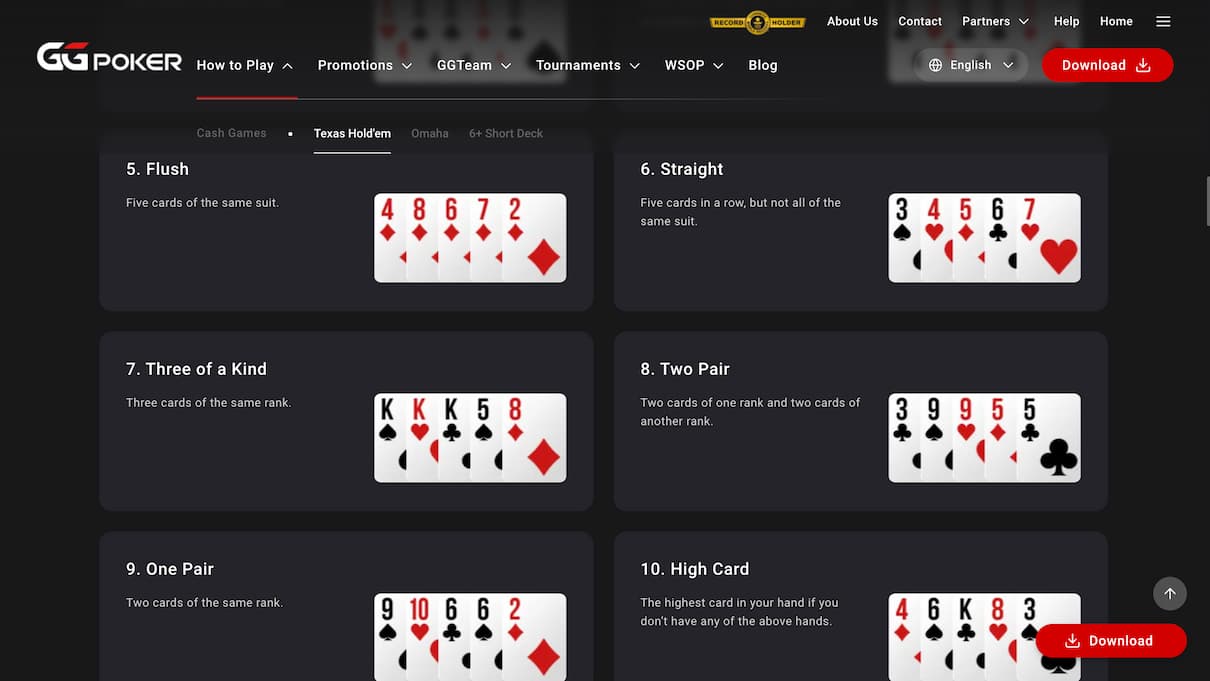How to Play Texas Hold’em Poker: Holdem Rules & Hands
Elliot Law, Senior Editor
Last Updated: 26/08/2025
Darragh Harbinson, Senior Editor
Fact-checker
Understanding Texas Hold’em rules is the first step to mastering one of the world’s most popular poker games. In this guide, you’ll find everything you need to confidently play Texas Hold’em – from hand rankings to betting rounds – explained in clear, beginner-friendly terms. We’ll show you how to make winning decisions, recognise the strongest hands, and follow proper table etiquette. Whether you’re just starting out or need a quick refresher, this article offers expert insights into the core rules and game-play mechanics. Get ready to join the table with confidence and sharpen your poker strategy with trusted, easy-to-follow guidance.
- Show full guideShow less
The Basics of Texas Hold’em Poker
The aim of Texas Hold’em Poker cash games, also known as Texas Hold’em poker, is to win chips by creating the best possible five-card hand or persuading your opponents to fold theirs. Players compete against each other, with the ultimate goal of collecting the most chips at the table.
▶️Winning the Game
In Texas Hold’em, you can win in two ways: either force all your opponents to fold before the final reveal or have the strongest hand at the showdown to claim the pot. Success, particularly in the pre-flop phase, depends on more than just your cards – it’s about reading your opponents, bluffing strategically, and making smart moves.
▶️How to Take the Pot
A hand can be won in two scenarios. First, you can win through clever betting and raising, causing all other players to fold before the showdown. Second, if the hand reaches a showdown, the player with the best five-card combination, made from their two private cards (hole cards) and the five shared cards (community cards), wins the pot.
▶️The Significance of the Best Five-Card Hand
At the heart of Texas Hold’em is crafting the strongest five-card hand, which determines the winner at the showdown. Knowing poker hand rankings – from a high card to a royal flush – is essential for success. By combining your hole cards with the community cards and keeping a close eye on what your opponents might have, you can gain an edge. Understanding probabilities, card rankings, and tactics is key to becoming a confident and consistent player at the table.
▶️Get Ready for the Table
Whether you’re playing at your local pub, a casino, or an online poker site, having a good grasp of the rules and strategies of Texas Hold’em is vital. Practice, patience, and observation are just as important as the cards themselves. So, shuffle up and deal – the next big pot could be yours!
How to Set Up a Game of Texas Hold’em
Texas Hold’em is a popular variation of poker that requires a standard 52-card deck and a minimum of two players to get started. Each player is dealt two private “hole cards,” while five shared “community cards” are revealed on the table during the game.
Number of Players (2–10)
Texas Hold’em can accommodate anywhere between 2 to 10 players, making it ideal for both intimate “heads-up” games with two players and larger, more social games with up to ten participants. Smaller games offer strategic one-on-one play, while larger tables bring more excitement and lively interaction.
Standard 52-Card Pack
A standard pack of 52 playing cards is used in Texas Hold’em, with no jokers in play. The deck is shuffled before each deal to maintain fairness and randomness, ensuring every hand is as unpredictable and thrilling as the last.
The Dealer Button
The dealer button is a crucial part of Texas Hold’em. It marks the player acting as the dealer for the current hand. In professional settings, there is a separate person dealing the cards, but in casual games, the dealer button rotates clockwise among the players. This rotation not only determines the order of play but also decides who posts the blinds.
The Blinds (Small Blind & Big Blind)
Blinds are mandatory bets placed by the two players sitting to the immediate left of the dealer button. The small blind and big blind are considered forced bets that ensure there’s always money in the pot to play for, even before the cards are dealt. These bets are pre-set and may increase over time, particularly in tournament formats, to keep the game competitive and engaging.
A Game for All Occasions
Whether you’re hosting a casual game night at home or participating in a high-stakes tournament at one of the best UK online casinos, Texas Hold’em offers endless opportunities for strategy, bluffing, and fun. With the right setup, you’ll be ready to enjoy this classic card game that’s loved across the UK and beyond.
The Texas Hold’em Game-play Structure
The Texas Hold’em game-play structure is designed to create a dynamic and strategic flow of action throughout each hand, which ultimately revolves around the strength of poker hands.
The Deal
At the beginning of each hand, each player is dealt two private cards, known as “hole cards.” These cards are dealt face down and are unique to each player, forming the foundation of their strategy for that hand. The goal is to use these cards, in combination with the community cards, to create the best possible five-card poker hand.
The Betting Rounds
The betting rounds in Texas Hold’em are structured to create opportunities for strategic decision-making and competitive play, where the betting action proceeds clockwise.
🃏 Pre-Flop – Once the hole cards are dealt, the first betting round begins. Players must decide whether to fold, call, or raise based on the strength of their hole cards and strategic considerations. The betting starts with the player to the left of the big blind and proceeds clockwise around the table.
🃏 The Flop – After the pre-flop betting round is complete, the dealer places three community cards face up in the center of the table. These are known as “the flop.” Players now evaluate how these cards interact with their hole cards and devise their strategy for the next round of betting.
🃏 The Turn – Following the flop betting round, a fourth community card, called “the turn,” is added to the board. At this stage, players gain more information and can reassess their hand’s potential. A new round of betting then takes place, allowing players to adjust their actions accordingly.
🃏 The River – The fifth and final community card, known as “the river,” is dealt face up on the table after the turn betting round concludes. With all community cards now revealed, players have their complete set of options to form the best five-card hand. A final round of betting occurs, setting the stage for the showdown.
Showdown
The showdown is the climactic moment of a poker hand, where all remaining players reveal their cards to determine the winner. After the final round of betting on the river, any players still in the hand must show their hole cards, and if there are identical hands, the pot is split. This stage puts the players’ strategies and decisions to the ultimate test, as the culmination of the game lies in revealing and comparing their hands.
🏆 Determining the Winner – If two or more players remain after the final betting round, the showdown occurs. Each player reveals their hole cards, and the best five-card hand is determined based on standard poker rankings. The player with the strongest hand wins the pot.
💰 Splitting the Pot (If Applicable) – In some cases, two or more players may have hands of equal value, resulting in a tie. If this happens, the pot is split evenly among the tied players. Furthermore, certain variations of the game may allow for splitting the pot based on specific rules, such as high and low hands in some versions of Texas Hold’em.
Texas Hold’em Hand Rankings (Best to Worst)
Getting to grips with hand rankings in Texas Hold’em is essential if you want to up your game. These rankings not only show the strength of your hand but also determine who takes home the pot in each round. Whether you’re just starting out or looking to sharpen your skills, knowing these rankings can help you make better choices and develop a winning strategy. From the unbeatable Royal Flush to the humble High Card, each hand has its place in the pecking order. Below, we’ll break down the rankings with examples to give you an edge at the table.
Royal Flush
The Royal Flush is the ultimate hand in Texas Hold’em and represents the strongest possible combination. It includes the Ace, King, Queen, Jack, and 10, all of the same suit (e.g., A♠, K♠, Q♠, J♠, 10♠). This rare hand is unbeatable under standard poker rules. Due to its rarity, many poker players go their entire careers without ever seeing a Royal Flush, making it a legendary and iconic hand in the game.
Straight Flush
A Straight Flush is just below the Royal Flush in ranking and consists of five consecutive cards all of the same suit. For example, 9♣, 8♣, 7♣, 6♣, 5♣ would form a Straight Flush. While still rare, a Straight Flush occurs more often than a Royal Flush. The highest possible Straight Flush – other than the Royal Flush – is often called the “Steel Wheel” (A♣, 2♣, 3♣, 4♣, 5♣). If two players hold Straight Flushes, the one with the higher high card wins.
Four of a Kind
Known in the UK as “quads,” Four of a Kind happens when a player holds all four cards of the same rank, such as four Kings (K♠, K♦, K♣, K♥). The fifth card, called the kicker, is used to determine the winner if multiple players have quads in the same hand. This hand is powerful and uncommon, making it one of the strongest in the game.
Full House
A Full House combines three cards of one rank with two cards of another, while a Flush occurs when a player has five cards of the same suit. For example, three Queens and two Tens (Q♠, Q♦, Q♣, 10♣, 10♦) create a Full House. The rank of the three matching cards determines the hand’s strength when compared to another Full House. For instance, a Full House with three Aces beats one with three Kings. Full Houses are strong hands and can often win in competitive situations.
Flush
A Flush occurs when a player has five cards of the same suit in any order, but not in consecutive sequence. For example, A♠, J♠, 8♠, 5♠, and 2♠ would form a Flush. When two players have Flushes, the one with the highest card in their hand wins. If the highest cards match, the second-highest cards are compared, and so on. Flushes are relatively common compared to hands like Full Houses or Straight Flushes, but they can still give you a strong edge in the game.
Straight
A Straight consists of five consecutive cards of any suit, but players must consider the minimum bet to stay in the game. For instance, 7♦, 6♠, 5♣, 4♥, and 3♦ make up a Straight. When comparing Straights, the hand with the highest top card wins. For example, a Straight ending with a King (K♠, Q♦, J♣, 10♥, 9♠) beats one ending with a Queen. The Ace can act as either high or low in a Straight, meaning the lowest Straight is A-2-3-4-5, while the highest is 10-J-Q-K-A.
Three of a Kind
Also referred to as trips or a set, this hand consists of three cards of the same rank alongside two unrelated cards. For example, J♠, J♣, J♦, 7♠, and 2♥ would form Three of a Kind. The strength of this hand is based on the rank of the three matching cards. If two players both hold Three of a Kind, the player with the higher-ranking trio wins. Typically, a set is formed when two of the matching cards appear in the community cards, while trips occur when the player has two matching cards in their own hand (hole cards).
Two Pairs
This hand, as the name suggests, consists of two separate pairs of cards and one unrelated fifth card. For example, two Eights and two Fives (8♠, 8♥, 5♦, 5♣, K♠) make up Two Pairs. The strength of this hand is determined by the higher-ranking pair. If two players hold the same two pairs, the winner is decided by the kicker – the unrelated fifth card, while the remaining player may wait for the next hand. This hand is fairly common and can win smaller pots when no stronger hands are in play.
One Pair
One Pair is a hand made up of two cards of the same rank and three unrelated cards. For example, K♠, K♦, 9♣, 6♦, and 3♥ would form One Pair. The strength of the hand depends on the rank of the pair. If two players hold the same pair, the winner is determined by the highest kicker among the remaining three cards. One Pair is one of the most frequent hands in Texas Hold’em and often struggles to win large pots unless it’s the top pair on the board.
High Card
When no other combination is made, the hand is ranked by its highest card. For example, if a player holds A♠, Q♦, 8♣, 5♠, and 2♥, this hand would be referred to as “High Card Ace.” If two players have High Card hands, the winner is decided by comparing the highest card, followed by the next highest, and so on. High Card is the weakest hand in Texas Hold’em and rarely wins unless all other players have similarly weak hands.
Understanding these hand rankings is essential for any poker player in the UK. By learning how the rankings work and applying them to game-play, you’ll be better prepared to assess your hands, anticipate moves from your opponents, and develop a smart strategy. Mastering these basics is a vital step on your journey to becoming a skilled Texas Hold’em player.
Understanding Betting Actions in Texas Hold’em
Getting to grips with betting actions in poker games, specifically Texas Hold’em, is key to making smart decisions during a game. Each action gives you the chance to influence the outcome and outplay your opponents. Here’s a breakdown of the main betting actions in UK poker terms:
- ✅ Check – A check happens when no one has placed a bet in the current round, and you opt not to bet either. By checking, you’re essentially passing the decision to the next player while staying in the hand without putting any chips on the line. You can only check if there’s no active bet to match.
- ✅ Call – Calling means you match the current bet made by an opponent. By doing so, you contribute an amount equal to the largest bet placed so far, keeping yourself in the running for the pot. Calling is common when you want to carry on in the hand without raising the stakes or folding.
- ✅ Raise – A raise happens when you increase the current bet during a round. This move signals strength and is often used to build the pot or put rivals under pressure. When raising, you match the current bet and add more on top, forcing others to either call your raise, re-raise, or fold. It’s a great way to test your opponents’ hands.
- ✅ Fold – Folding is when you throw in your cards, forfeiting your chance to win the hand. This is the go-to action if you reckon your hand isn’t strong enough to compete. Once you fold, you’re out of the current betting round and won’t put any more chips into the pot.
- ✅ All-In – Going all-in means betting every chip you’ve got in your stack. It’s a bold move and usually shows supreme confidence in your hand – or it could be a clever bluff. If someone calls your all-in, the hand moves to a showdown, and the winner scoops the lot. If no one calls, you win the pot outright without revealing your cards.
Mastering these betting actions will give you an edge at the poker table, helping you stay in control and develop tactics to outmanoeuvre your opponents like a true pro.
Common Poker Terms and Table Etiquette in the UK
Getting familiar with key poker terms and practising proper table manners is crucial for an enjoyable and respectful game in the UK. With over 2,700 operational poker tables in the UK and countless online offerings, these are terms worth knowing.
- The Button, Blinds, and Community Cards – The “button” represents the dealer position, which moves clockwise around the table after each hand. The small blind and big blind are compulsory bets placed by the two players sitting to the left of the button. These ensure there’s action in every hand. Community cards are the shared cards dealt face-up in the middle of the table, which all players can use to form their best hand.
- The Pot, Showdown, and Muck – The “pot” is the total amount of chips wagered during a hand, which the winner takes at the end. A “showdown” happens when the remaining players reveal their hands at the end of the final betting round to decide the winner. The term “muck” refers to discarding your cards without showing them, a common practice when folding or losing a showdown.
- Taking Your Turn and Mind Your Timing – In poker, playing in turn is essential. Acting out of turn can disrupt the flow of the game and create confusion for others at the table. It’s also important to be considerate with your decision-making time – taking too long can frustrate other players, while prompt decisions keep the game moving smoothly. Following these unwritten rules ensures a better atmosphere and a more enjoyable experience for everyone at the table.
Poker Strategy Tips for Beginners in the UK
Starting out in poker can be both exciting and challenging. To help you improve your game and grow your confidence at the table, especially in limit games, we’ve put together some essential poker strategies tailored for beginners in the UK.
Tip #1 Choosing the Right Starting Hands
Your starting hand selection is one of the most important decisions in poker. Focus on strong hands like high pairs (e.g., Aces or Kings), suited connectors (like 9 and 10 of Hearts), or high-value cards. Avoid the urge to play every hand, as this can quickly drain your chips. Be selective and disciplined, basing your decisions on the strength of your starting hand.
Tip #2 Understanding Table Position
Position at the table plays a huge role in making smart decisions. Players in late positions (closer to the dealer button) get to observe other players’ actions before deciding on their own, giving them an edge. If you’re in an early position, play cautiously and stick to strong hands. In middle or late positions, you can afford to be more aggressive and take advantage of opportunities.
Tip #3 Managing Your Bankroll
Good bankroll management is vital for staying in the game and avoiding unnecessary stress, especially when dealing with equal bets. Only play at stakes that you’re comfortable losing without financial strain. A general rule, especially in pot limit games, is to have 20-30 buy-ins for the stakes you’re participating in. This approach helps you weather losing streaks and ensures a steadier progression.
Tip #4 Bluffing for Beginners
Bluffing is a core part of poker, but beginners should approach it cautiously. Effective bluffing requires knowing your opponents and the context of the game. Start small – bluff in situations where your bets make logical sense, such as representing a strong hand on a dangerous board. With time and practise, you’ll improve this skill while avoiding reckless plays.
💡 Pro Tip: Playing at online casinos with no verification allows you to enjoy a more private gambling experience which makes it harder for your opponents to track your actions and take advantage by bluffing.
Online vs. In-Person Texas Hold’em
If you’re a beginner stepping into the world of Texas Hold’em here in the UK, it’s important to know the difference between playing online, where every game the small blind varies, and playing in-person. Each format offers unique perks and challenges, so tailoring your approach can help you succeed. The popularity of online poker in the UK has doubled in recent years, let’s see why.
Feature Online Texas Hold’em In-Person Texas Hold’em Pace of Play More fast-paced with several hands played per hour. Slower-paced due to physical hands and dealing. Convenience/Accesibility Play anytime, anywhere 24/7 at online poker rooms across all poker game variations. More limited due to venue opening hours and table availability, requires travel. Opponent Reads Based on timing and betting patterns, no opportunity to observe opponents behaviour. Based on physical cues and table talk. Cost/Stakes Typically lower rake and lower overheads. Lower minimum stakes and potentially much higher maximum stakes. Generally higher rake, expect to tip dealers. Higher minimum stakes but maximum stakes will be limited by venue. Security Concerns over bots and RNG fairness, although reputable sites are audited. Physical security and cameras in casinos, direct observation of play but potential for cheating between players. Multi-Tabling Options Can play multiple tables simultaneously. Can only physically play one table at a time. Some players also explore crypto casinos in the UK, which offer decentralised payment options and greater anonymity compared to traditional platforms.
Conclusion
Getting to grips with Texas Hold’em takes a solid understanding of the rules, hand rankings, and the ins and outs of various formats. Whether you prefer online play for its convenience and fast pace or live games for the social and strategic aspects, adjusting your approach to suit the setting is essential. Learning the key poker hands and their rankings will give you a strong starting point. Most importantly, keep practising to polish your skills, and always gamble responsibly – the main goal is to enjoy the game.
FAQs
What are the basic Texas Hold ’em rules for UK players?Texas Holdem rules are the same worldwide, and in the UK, poker games follow standard international formats. Each player is dealt two private cards, and five community cards are dealt in stages. The game begins with the player clockwise from the button posting the small blind, and the next posting the big blind. Betting continues through four rounds – pre-flop, flop, turn, and river. The best five-card poker hand wins the pot at showdown.How does the final betting round work in Texas Hold’em poker?In UK poker games, the final betting round – also known as the river – starts after the fifth community card is dealt. The active player immediately clockwise from the dealer acts first. Players can check, bet, call, or fold, following the same betting rules used in earlier rounds. Once betting action is completed, remaining players reveal their cards. The best poker hand wins, with all standard hand rankings in play.What is pot limit in Texas Holdem poker?Pot limit Texas Holdem poker is a popular format in both UK casinos and online sites. Here, the maximum a player can bet or raise equals the current pot size. The game begins with the small blind and big blind, and each subsequent bet or raise must not exceed the total pot. This betting structure adds strategic depth and controls risk compared to no-limit variants.What happens during the pre flop round in Texas Hold’em games?In Texas Hold’em games across the UK, the pre flop round begins once all players receive two private cards. The first to act is the player immediately clockwise from the big blind. Players can call, raise, or fold. In a limit game, the small blind is usually half the size of the big blind. Once betting is completed, the dealer spreads the flop and betting continues with the same rules.How do you rank poker hands to win in Texas Hold’em?Winning at Texas Hold’em poker in the UK requires making the best five-card combination from your two hole cards and five community cards. Rankings are standard: a royal flush beats all, followed by straight flush, four of a kind, and down to just one pair. If two players tie, the higher kicker or the player who made the previous bet may take the pot, or it may be split.Can I play Texas Hold ‘Em for free in the UK to practice?Yes, UK players can enjoy free poker games on many sites. These games let you play Texas Hold ‘Em without wagering real money – ideal for learning the betting rules and understanding how community cards are dealt. The game begins with the blinds, the action moves clockwise from the button, and players follow the same betting structure as in live games, all risk-free.Resources
Elliot Law, Senior Editor
Elliot has a background in journalism which he combines with his extensive gambling knowledge to bring you in-depth, honest reviews, guides, and articles. After years in the field of iGaming and online sports betting, he aims to give you the hottest tips and guide you towards the best online gambling platforms in the industry.
This article has been Fact-checked by Darragh Harbinson
We prioritize accuracy, objectivity, and depth in every piece of content we produce. Our rigorous editorial standards ensure that all information is carefully sourced and fact-checked. Each article is meticulously reviewed by experienced editors and leading technology professionals to maintain the highest level of credibility and relevance. This commitment guarantees our readers content they can trust and rely on.
From breaking news and in-depth match analysis to exclusive interviews and behind-the-scenes content, we bring you the stories that shape the esports scene.
40k+Monthly Visitors
100%User Satisfaction
10+Years experience
Popular Pages












